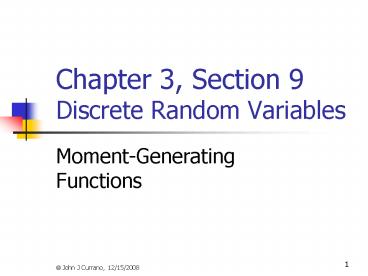Chapter 3, Section 9 Discrete Random Variables - PowerPoint PPT Presentation
1 / 12
Title:
Chapter 3, Section 9 Discrete Random Variables
Description:
Let Y be a discrete random variable with probability function, p(y), and let k = 1, 2, 3, ... Using the Maclaurin Series for ex at the right, we derive ... – PowerPoint PPT presentation
Number of Views:68
Avg rating:3.0/5.0
Title: Chapter 3, Section 9 Discrete Random Variables
1
Chapter 3, Section 9Discrete Random Variables
- Moment-Generating Functions
? John J Currano, 12/15/2008
2
Definitions. Let Y be a discrete random variable
with probability function, p(y), and let
k 1, 2, 3, ?. Then
is the kth moment of Y (about the origin).
is the kth moment of Y about c.
is the kth central moment of Y.
Notes. ? E(Y) the first moment of Y (
?1?) ? 2 V(Y) the second central moment
of Y ( ?2 ) E(Y 2) E(Y )2 ?2?
(?1?) 2. What is the first central moment of Y
?
3
Definition. If Y is a discrete random variable,
its moment-generating function (mgf) is the
function
provided this function of t exists (converges) in
some interval around 0. Note. The mgf, when it
exists, gives a better characterization of the
distribution than the mean and variance it
completely determines the distribution in the
sense that if two random variables have the same
mgf, then they have the same distribution. So to
find the distribution of a random variable, we
can find its mgf and compare it to a list of
known mgfs if the mgf is in the list, we have
found the distribution. We shall also see that
the mgf gives us an easy way to find the
distributions mean and variance.
4
Why it is called the moment-generating function
Using the Maclaurin Series for ex at the right,
we derive
by Theorem 3.2
using the Maclaurin series for ety
interchanging the summations
by Theorem 3.2
5
Why it is called the moment-generating function
Thus,
et cetera.
6
Theorem. for k 1, 2, 3, . . . where mY
(t ) is the mgf of Y (provided it exists).
Also, mY (0) E(e0Y) E(1) 1 for any RV, Y.
Example (p. 142 3.155). Given that
find (a) E(Y) (b) V(Y) (c) the
distribution of Y.
(a) (b) Thus, V(Y) E(Y 2) ? E(Y)
7
Theorem. for k 1, 2, 3, . . . where mY
(t ) is the mgf of Y (provided it exists).
Also, mY (0) E(e0Y) E(1) 1 for any RV, Y.
Example (p. 142 3.155). Given that
find (a) E(Y) (b) V(Y) (c) the
distribution of Y.
(c) Since and the support of Y
consists of the coefficients of t in the
exponents of the powers of e in the nonzero terms
of the power series, Y has support 1, 2, 3.
The probability that Y assumes each of these
values is the coefficient of the exponential in
the corresponding term, so
Y 1, 2, 3, with probabilities
respectively.
8
Example. Find the moment-generating function of
Y bin(n, p) and use it to find E(Y) and V(Y).
Solution. Then,
by Theorem 3.2
(pet q)n by the Binomial Theorem
9
Now differentiate to find E(Y) and V(Y)
(a) (b)
10
Example. If the moment-generating function of a
random variable, Y,
, find Pr(Y 2 or 3).
Solution. From the form of the moment-generating
function,
we know that Y
, so that
P(Y 2 or 3)
P(Y 2) P(Y 3)
11
Homework Problem Results (pp. 142-143)
3.147 If Y Geom(p), then
3.158 If Y is a random variable with
moment-generating function, mY(t), and W aY b
where a and b are constants, then mW (t) maYb
(t) e t b mY (at ).
12
Other Moment-Generating Functions
1. If Y NegBin(r, p), then
This is most easily proved using results in
Chapter 6. Exercise. Use mY(t) to find E(Y) and
V(Y).
2. If Y Poisson(?), then
This is Example 3.23 on p. 140, where it is
proved and then used (in Example 3.24) to find
E(Y) and V(Y).































